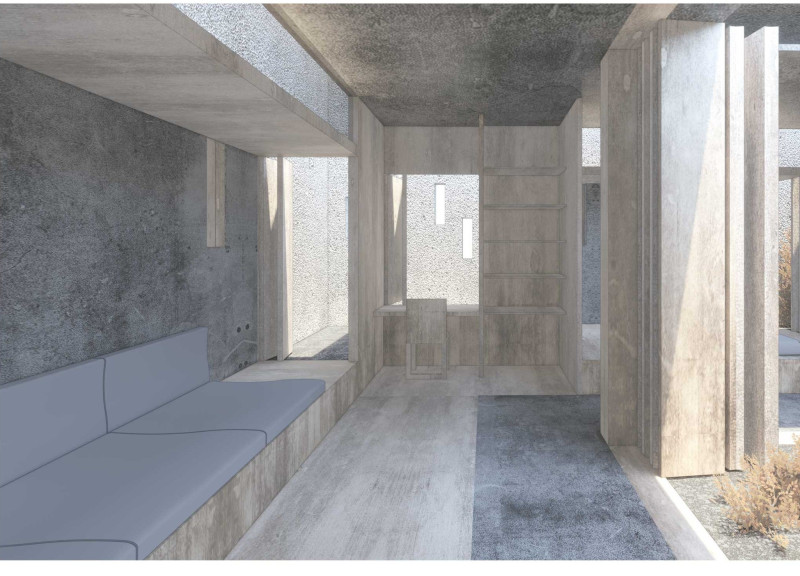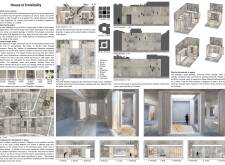5 key facts about this project
The primary objective of the House of Invisibility is to enhance the sensory engagement of its occupants. Rather than simply focusing on visual appeal, the design invites users to experience the space through touch, sound, and other senses. This approach challenges traditional notions of visibility in architecture, transforming how inhabitants interact with their surroundings.
Key components of the project include a central courtyard that facilitates natural light and airflow, providing a serene atmosphere amidst the urban context. The space is divided into functional zones featuring a living room, dining area, kitchen, and private spaces such as bedrooms and bathrooms, all thoughtfully arranged to promote fluid circulation. The ninth square grid layout offers logical pathways between these spaces, further encouraging exploration and connectivity.
Materiality plays a vital role in the overall design of the House of Invisibility. The use of speckled and polished concrete provides a firm structural element while contrasting with warm polished wood finishes used in the furniture and internal partitions. Natural elements, such as skin vegetation, enhance the tactile sensations within the house, contributing to a unique sensory experience.
Unique Design Approaches
What distinguishes this project from typical residential designs is its deliberate focus on sensory experience, positioning itself as an architectural exploration into how individuals perceive and interact with their environment. The integration of various textures and materials invites occupants to engage with the house through touch and sound, setting it apart from conventional designs that predominantly emphasize visual aesthetics.
Another noteworthy aspect is the deliberate use of the central courtyard as a social and climatic mediating space. This design element allows for a transition between the bustling urban life outside and the private nature of home life, thereby fostering a sense of tranquility and community within the public sphere.
Spatial organization further enhances the functionality of the house. Defined pathways guide movement through the various zones, allowing occupants to navigate effortlessly between public and private areas. The layout effectively balances openness with intentional privacy, accommodating both social interaction and personal retreat.
Innovative Materials and Sustainability
The architectural materials used in the House of Invisibility play a pivotal role in its expression and functionality. The careful selection of speckled concrete not only serves a structural purpose but adds a distinctive visual texture to the floors and walls. The polished wood elements contribute warmth and comfort, bridging the gap between the harsh urban environment and the inviting atmosphere of the home. The incorporation of skin vegetation further emphasizes sustainability while enhancing the overall sensory experience by bringing a touch of nature indoors.
The project's attention to detail and innovative design approaches render it a significant addition to contemporary residential architecture. For an in-depth exploration of the architectural plans, sections, and design ideas that shape this unique project, we encourage readers to delve into the comprehensive project presentation. This examination will provide valuable insights into how the House of Invisibility redefines sensory experience in architectural design.























